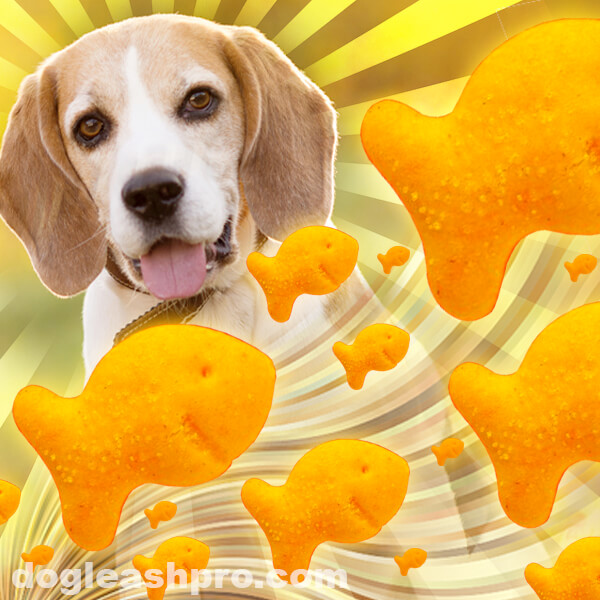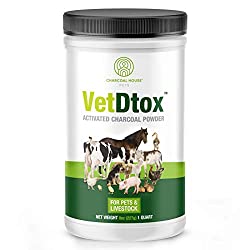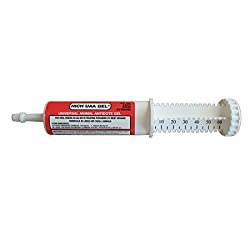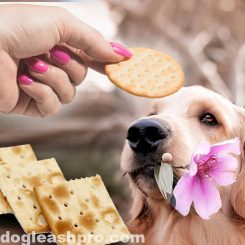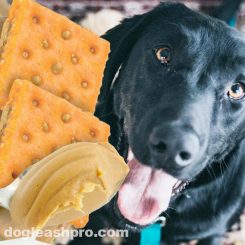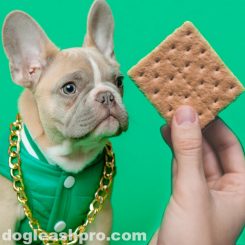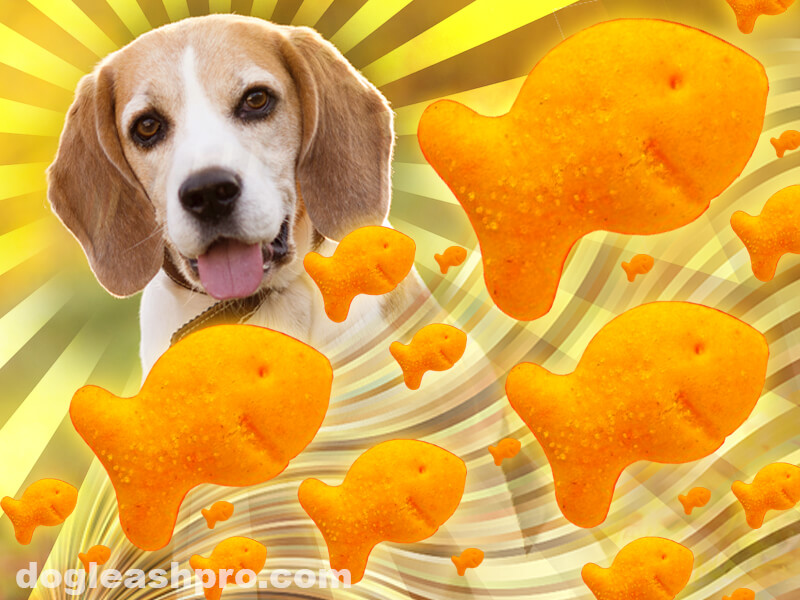
Who doesn’t love Goldfish crackers right? Not only is this fun snack shaped like a fish, but also they are small, crunchy, and tasty, just like Animal Crackers! While we love eating this salty Goldfish cracker, sometimes we feel generous and have a tendency to share it with our dogs. However, before you give one to your furry friends, find out if Goldfish is safe for them to eat.
Can dogs eat Goldfish? No, dogs should not eat Goldfish, but one or two pieces of Goldfish are fine. The Goldfish cracker contains a high level of salt and fat. There are also seasonings and coloring in Goldfish that are harmful to dogs. Due to this, it’s best to keep Goldfish away from your canine friends.
Table of Contents
Can dogs have Goldfish?
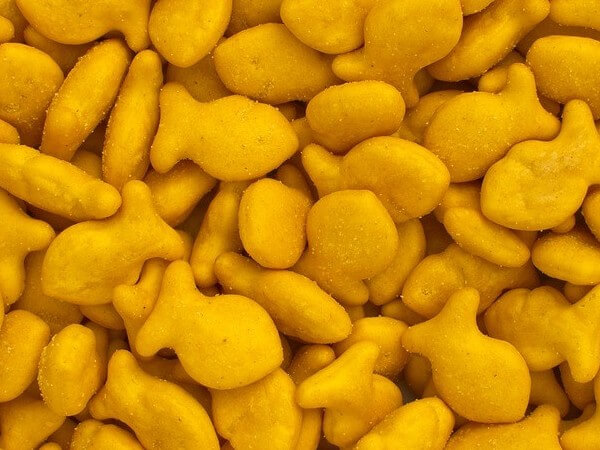
Dogs should not have Goldfish. It is best to keep the Goldfish crackers away from your canine friends because this snack is high in calories and is packed full of fat and salt.
Goldfish is a fun snack made for human consumption. The ingredients in this cheddar snack are fine for humans, but they are not healthy or safe for dogs.
Can dogs eat Goldfish Crackers?
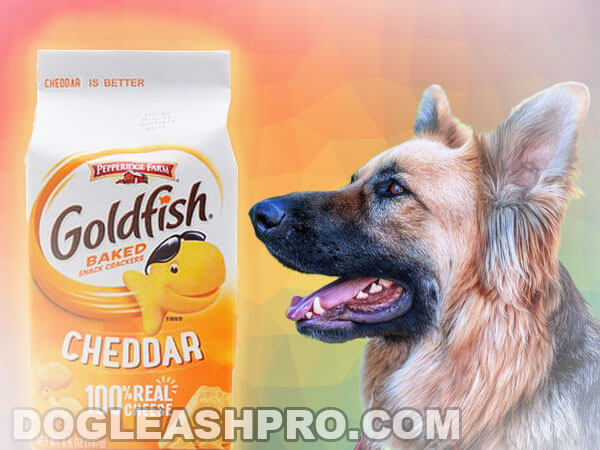
As we can see, dogs should not eat Goldfish crackers. While these cute and golden Goldfish Crackers look harmless, don’t let their size fool you. Being that these Crackers are pretty tiny, it’s very easy for dogs to consume a whole bunch of them at one time.
Now here’s how Goldfish Crackers can affect your dog’s safety.
Are Goldfish safe for dogs?
If you’re not watching, your furry friends may steal a mouthful or two of Goldfish Crackers. This can potentially be dangerous, especially when you’re not aware or aren’t around.
First, eating a lot of Goldfish Crackers at one time can become a choking hazard. The Goldfish Crackers can get stuck in your dog’s throat, which is life-threatening.
Second, since Goldfish Crackers can be very salty, you’ll want to make sure that there’s always a fresh bowl of water around in case your pup becomes very thirsty from eating the Crackers.
Are Goldfish bad for dogs?
Yes, Goldfish is bad for dogs if consumed regularly. Let’s take a look at the ingredients that are used to make Goldfish and discuss in detail why these ingredients are bad for dogs.
For now, you’re probably wondering what’s the harm in feeding your furry friends Goldfish since this baked snack is cute and small. If you’re still wondering, “Can dogs have Goldfish crackers?” or “Can dogs eat Goldfish snacks?” we recommend that owners keep the Goldfish crackers away from their furry friends.
If you must, feeding your canine friends a few Goldfish won’t hurt them, but don’t definitely don’t give them more than that.
Let’s explore the ingredients in Goldfish to understand why this snack is not good for dogs.
Goldfish Crackers ingredients
Here are the ingredients in Goldfish crackers.
The Goldfish crackers contain several primary ingredients such as:
- Enriched wheat flour (flour, niacin, reduced iron, thiamine mononitrate, riboflavin, folic acid)
- Cheddar cheese ([cultured milk, salt, enzymes], annatto)
- Vegetable oils (canola, sunflower and/or soybean)
- Salt
Each Goldfish Cracker has 2% or less of the following:
- Yeast.
- Sugar.
- Autolyzed yeast extract.
- Paprika.
- Spices.
- Celery.
- Onion powder.
- Monocalcium phosphate.
- Baking soda.
Taking a brief look at the ingredients in Goldfish crackers, you can see that this crispy snack is made for human consumption.
To understand how some of the ingredients can be harmful to our furry friends, we will go over them and discuss how they could potentially affect your pups’ health.
Enriched wheat flour provides no nutritional value to dogs
Enriched wheat flour is the predominant ingredient in these Goldfish crackers. While it is not toxic to our furry friends, it is certainly not the best for them either.
Enriched wheat flour means that it is not 100% whole wheat. When flour is enriched, the natural nutrients are stripped away, which is why manufacturers will add back the nutrients such as niacin, folic acid, thiamine mononitrate, and riboflavin.
Additionally, the highly processed and refined grain provides only simple carbohydrates, which means it does not provide your precious pooch with any nutritional value. Instead, when your furry friends eat snacks that contain enriched wheat flour, their sugar level will spike briefly so they will be energetic for a short period of time before their energy level decreases and crashes.
Not only that, enriched wheat flour is what we call empty carbs. Dogs that eat Goldfish crackers will increase their calorie intake without receiving any nutritional benefits. This can lead to weight gain. Continuously feeding your pooch Goldfish can lead to health issues such as obesity and diabetes.
Lastly, their digestive system is not able to digest grains well. Dog owners should feed their dogs with canine-friendly food that is easy for their digestive system.
The Goldfish crackers nutrition label tells us that the enriched wheat flour was made from flour, niacin, reduced iron, thiamine mononitrate, riboflavin, and folic acid.
Niacin, riboflavin, folic acid, thiamine are all part of the B vitamins. This group of B vitamins is essential to your dog’s body and health.
Niacin and riboflavin both play a crucial part in your furry friend’s enzyme function.
Folic acid helps our canine friends with the following:
- Mitochondrial protein synthesis (allows dogs to stay healthy and active).
- Nucleotide metabolism (helps make new RNA and DNA in dogs).
- Amino acid (build and synthesize protein in your dog’s body).
Thiamine regulates your pup’s carbohydrate metabolism and energy. It also turns on ion channels in their neural tissue.
While these added nutrients are safe and beneficial to your canine pups, it’s best that they receive these nutrients from their regular dog food and dog-friendly treats.
Cheddar cheese with annatto vegetable dye is harmful to dogs
Cheddar cheese is safe for dogs to eat. In fact, it is a great source of protein for your four-legged pups who will most likely love the strong smell of the cheese as well.
Cheddar cheese contains essential nutrients that your dogs need such as vitamin B and calcium.
However, it’s important to keep in mind that cheddar cheese is a dairy product so it may not sit well with your dog’s digestive system if they are lactose intolerant. The Goldfish crackers nutrition facts label tells us that the cheddar cheese is made from cultured milk, salt, and enzymes. Before feeding your pooch cheddar cheese, make sure they are tolerant of dairy food.
Another factor to consider is that the yellow color of the Goldfish crackers comes from a vegetable dye called annatto. According to The Washington Post, annatto is an artificial coloring used to make Goldfish crackers very yellow and it can cause seizures in some dogs.
Instead of feeding your pups yellow cheese that has high salt content, it’s best to feed them white cheddar cheese or low-fat mozzarella cheese instead. Dogs don’t need that much salt in their diet. In fact, eating too much Goldfish can lead to sodium poisoning in dogs.
Too much salt can lead to sodium poisoning in dogs
Speaking of salt, one serving size or 55 pieces of Goldfish crackers contains 250 mg of salt. This means that just one piece of Goldfish cracker alone contains 4.5mg of salt. Accidentally eating a lot of Goldfish crackers can be dangerous to your pups’ health.
Since Goldfish crackers are very small, it’s easy to give your pooch a lot of them at once.
Keep in mind that our furry pals should only get their normal salt intake from their main meal. Dogs should only have between 0.25g to 1.5g of salt for every 100g of regular dog food. Going over this limit can lead to sodium poisoning.
Signs of salt poisoning in dogs include:
- Excessive thirst leading to frequent urination.
- Swelling in the face and body.
- Diarrhea.
- Vomiting.
- Disorientation.
- Muscle tremors.
- Weakness.
- High temperature.
- Depression.
- Seizures (in severe cases).
If you notice any of these symptoms in your pooch after they have eaten Goldfish crackers, be sure to contact your vet as soon as possible.
If you give your four-legged friends just 27 pieces of Goldfish crackers, it would already be almost half of their daily salt intake limit.
For this reason, try to avoid feeding your pooch Goldfish crackers. If you have to, feed them a few Goldfish in moderation.
Vegetable oils used to make Goldfish are not healthy for dogs
The vegetable oils used to make Goldfish are not safe for dogs, except for sunflower oil. Sunflower oil along with coconut oil, fish oil, flaxseed oil, and olive oil are great for our canine companions.
Since canola oil and soybean oil are used, it’s best to avoid giving Goldfish crackers to our pups. Some dogs have soy allergies and will experience major discomfort and even stress after eating food with soybean oil.
While canola oil is not toxic to dogs, it’s best to give our precious pooch oil that is safe and healthy for them such as the ones we’ve mentioned.
Additionally, our pooch should get their fatty acids from their well-balanced healthy dog food. They don’t need extra or unnecessary oil, especially from salty snacks like Goldfish crackers, to be added to their daily diet.
Fun Fact: Vanilla wafers also use vegetable oil. Vegetable oil usually includes soybean oil and canola oil. Find out if vanilla wafers are safe for doggy consumption by checking out our article on Can Dogs Eat Vanilla Wafers?
Onion powder is toxic to dogs
Onions in all forms, whether powdered, dehydrated, cooked, fried, or raw is toxic to dogs. Therefore, it’s important that pet owners keep any food that contains onion powder or onions away from their canine companions.
Although onion powder may seem harmless to us, it is extremely harmful to dogs. Every part of the onion is toxic to dogs, including the processed powders, juice, leaves, and flesh!
Although Goldfish crackers contain 2% or less of onion powder, it’s best to keep this crunchy snack away from your pooch. Onion is one of the most toxic human foods for our furry friends and it’s not worth the risk of feeding them food with onion, not even a tiny amount of onion powder.
When dogs eat food or snacks that contain onion, it can damage their red blood cells. In severe cases or eating too much onion can likely lead to hemolytic anemia in dogs.
Some signs and symptoms of onion toxicity include:
- Difficulty breathing.
- Vomiting.
- Loss of appetite.
- Weakness.
- Fainting.
- Lethargy.
- Panting.
- Jaundice.
- Reddish color urine.
- Loss of color in the gums.
- Increase heart rate.
The onion powder ingredient found in Goldfish is, unfortunately, more potent than fresh onions. The canine’s nose is powerful and they may be attracted to the smell of Goldfish and would happily chomp down an open bag of Goldfish crackers if their owner isn’t looking.
Since onion powder is listed as an ingredient in Goldfish crackers, we highly recommend that you do not feed your fur friends this snack. If your precious pooch ate some Goldfish Crackers or is experiencing some of the symptoms listed above, please contact your vet right away.
If your vet’s advice, bring your pooch to the veterinary hospital for a checkup. Your vet will perform a series of tests, including blood work to properly diagnose your pup’s condition. If your vet finds hemolytic anemia or the formation of Heinz bodies on the blood smear, then your pup has onion toxicity.
Goldfish crackers nutrition
Nutritional Profile of Goldfish crackers (1 serving size, 55 pieces, 30g)
| Name, Unit | Amount |
| Calories, cal | 140 |
| Total Fat, g | 5 |
| Saturated Fat, g | 1 |
| Cholesterol, mg | 10 |
| Sodium, mg | 250 |
| Total Carbohydrate, g | 20 |
| Protein, g | 3 |
| Calcium, mg | 40 |
| Iron, mg | 1.3 |
| Potassium, mg | 50 |
| Thiamin, mg | 0.15 |
| Riboflavin, mg | 0.17 |
| Niacin, mg | 2.3 |
| Folate, mcg | 75 |
| Folic acid, mcg | 45 |
A serving size or 55 pieces of Goldfish crackers has 140 calories, 5 grams of fat (1 grams saturated), and 20 grams of carbohydrates.
So in 1 serving size of Goldfish crackers, about 40% is fat. If you let your canine friends munch on this crunchy snack, it is very much like eating raw fat. Eating a few pieces of the Goldfish cracker should be fine, but since this snack is very small and looks appealing, it wouldn’t be surprising if your pooch accidentally ingested a lot of it when you are not aware or watching.
For this reason, we highly recommend that you keep the Goldfish packet out of your furry friend’s reach so that your furry pal can’t get a hold of it. Putting this on top of your refrigerator or inside a closed cabinet should work. This prevents the Goldfish packet from accidentally spilling. You know who will eat the spilled Goldfish cracker on the floor.
Let’s take a closer look at the calories and fat in just one piece of Goldfish cracker.
Nutritional Profile of Goldfish crackers (1 piece, 0.5g)
| Name, Unit | Amount |
| Calories, cal | 2.5 |
| Total Fat, g | 0.1 |
| Sodium, mg | 4.8 |
| Total Carbohydrate, g | 0.4 |
| Protein, g | 0.1 |
| Calcium, mg | 0 |
| Iron, mg | 0 |
| Potassium, mg | 1.1 |
A single piece of Goldfish cracker would most likely do no harm to your furry friends. It has about 3 calories, 0.1 grams of fat, and 0.4 grams of carbohydrate.
What if my dog ate Goldfish crackers?
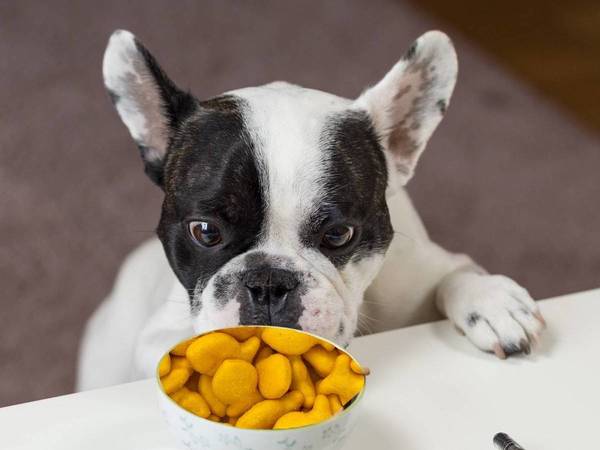
Provide plenty of cool water if your pooch ate way too many Goldfish crackers. Expect your canine friends to become very thirsty after eating a lot of Goldfish crackers.
By drinking plenty of water, it will help to flush out the toxic ingredients from your dog’s body. Observe your pooch closely and see if he has any of the symptoms listed above.
If you’re unsure and are worried, feel free to call your vet. Your vet may ask you to bring your pooch in for a checkup or give you proper direction on what you can do to help.
Treatments if your dog has poisoning from Goldfish crackers
Timely treatment for dogs with food poisoning is crucial. Depending on the type of toxicity or poisoning your canine friends have, your vet will provide different treatment options available to stabilize their condition so they can recover nicely.
Treatment includes IV to keep your dogs hydrated and to flush the toxin from your pup’s bloodstream. The vet may induce vomiting or flush out your puppy’s stomach to remove the toxins. Your vet may also use activated charcoal to absorb the toxins from your dog’s digestive tract.
Your four-legged friends may have to stay in the veterinary hospital overnight so that the vet can monitor your dog’s body closely and make sure your furry pals start to produce red blood cells again.
In some severe cases of poisoning where your dog ate the whole package of Goldfish crackers, your vet may have to do an oxygen supplementation or a full blood transfusion. If your pooch ate several Goldfish crackers, this may not be necessary.
Healthy alternatives to Goldfish crackers that is dog-friendly and safe
Instead of feeding your pooch Goldfish crackers, here are some healthy fruits and vegetables that will provide your pups with complex carbohydrates, vitamins, and minerals.
Brussel sprouts: Cooked Brussel Sprouts have an aromatic smell that dogs love. They are packed full of vital minerals, vitamins, and fiber. Make sure to cook them fully before you feed them to your pooch.
Watermelon: During hot summer days, cut up some cold watermelon. It’s a refreshing snack for your four-legged friends and will keep them cool and hydrated. Your dogs will also love the sweetness and crunchiness of this fruit. Watermelon is low in calories and high in essential vitamins, minerals, and antioxidants.
Oranges: Instead of the artificial orange color of the Goldfish cracker, have your canine companions try some real oranges! They are loaded with fiber and key vitamins that can help your pooch. Since this fruit does contain sugar, avoid feeding them to your pups if they are diabetic or overweight.
Pumpkin: Pumpkin is another fruit that is healthy for dogs. It is tasty and easy on your dog’s digestive system. Your pooch will receive tons of helpful minerals, vitamins, and fiber. Pumpkin also promotes a healthy gut in dogs.
So, can dogs eat Goldfish?
Your dogs’ health should always come first when you’re deciding what to feed them. We highly recommend that owners keep snacks that are high in salt, fat, and calories away from their canine family members. Feeding them these unhealthy snacks can lead to many health problems we discussed above.
If your pooch wants a snack or treat, it’s best to give them healthy options such as dog-friendly fruits and vegetables. Remember that a healthy dog is a happy dog!
Related Questions
Absolutely not. Extra cheddar Goldfish contains more harmful ingredients than the original Goldfish crackers such as garlic powder and citric acid. Additionally, sodium is higher in Goldfish xtra cheddar of 260 mg in one serving of 51 pieces of Goldfish compared to 250 mg in one serving of 55 pieces of Goldfish.
One or two Goldfish xtra cheddar is fine. Please avoid feeding your pup too many xtra cheddar Goldfish.
Dogs should not eat original Goldfish crackers, but feeding them a few Goldfish crackers should be fine.
It’s best that dogs do not eat cheddar Goldfish. The Goldfish cracker snack is not healthy for dogs and contains ingredients that are harmful to them as well.
Dogs should not have flavor blasted Goldfish. It contains ingredients such as dehydrated onions and garlic, citric acid, and butter oil that are not only harmful to dogs but also unhealthy. In one serving size or 51 pieces of Goldfish crackers, there is 270 mg of sodium. This is more sodium than the original Goldfish cracker.
One or two flavor blasted Goldfish should be fine, but don’t offer your pooch too many.
Generally, the more creative the Goldfish snack gets, the more toxic it is to your canine companions because there are more added ingredients that are harmful to them.
DISCLAIMER: THIS WEBSITE DOES NOT PROVIDE MEDICAL ADVICE
The information, including but not limited to, text, graphics, images and other material contained on this website are for informational purposes only. No material on this site is intended to be a substitute for professional veterinary advice, diagnosis, or treatment. Always seek the advice of your veterinarian or other qualified health care provider with any questions you may have regarding dietary needs.
GOLDFISH is a registered trademark of Pepperidge Farm, Incorporated. Dogleashpro does not claim any ownership of the GOLDFISH name, logo, or any identifying mark in any way. This article is for educational purposes only.
Resources:
https://en.wikipedia.org/wiki/Goldfish_(cracker)

With over five years of specialized experience as an animal writer, my expertise lies in dog nutrition, health, behavior, grooming, and training. I am dedicated to delivering helpful and informative content that caters to the well-being of our furry friends. My primary goal is to empower pet owners with knowledge and ensure our canine companions thrive in health and happiness. In my free time, I love volunteering at local dog rescue centers.
